
Charles Carroll, known as Charles Carroll of Carrollton or Charles Carroll III, was an Irish-American politician, planter, and signatory of the Declaration of Independence. He was the only Catholic signatory of the Declaration and the longest surviving, dying 56 years after its signing.

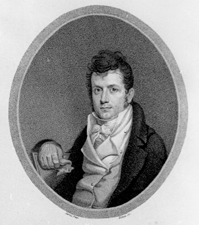
Alexander Contee Hanson was an American lawyer, publisher, and statesman. He represented the third district of Maryland in the U.S. House, and the state of Maryland in the U.S. Senate.
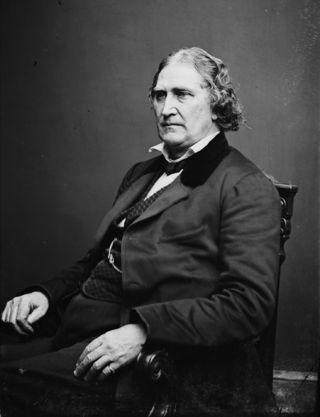
James Asheton Bayard Jr. was an American lawyer and politician from Delaware. He was a member of the Democratic Party and served as U.S. Senator from Delaware.
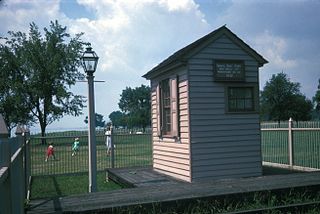
The New Castle and Frenchtown Turnpike and Rail Road (NC&F) was opened in 1831, was the first railroad in Delaware and one of the first in the United States. About half of the route was abandoned in 1859; the rest became part of the Pennsylvania Railroad (PRR) route into the Delmarva Peninsula and is still used by Norfolk Southern Railway. The abandoned segment from Porter, Delaware, to Frenchtown, Maryland, the New Castle and Frenchtown Railroad Right-of-Way, was listed on the National Register of Historic Places in 1976.

The Philadelphia, Wilmington and Baltimore Railroad (PW&B) was an American railroad that operated independently from 1836 to 1881.
Benjamin Henry Latrobe II was an American civil engineer, best known for his railway bridges, and a railway executive.
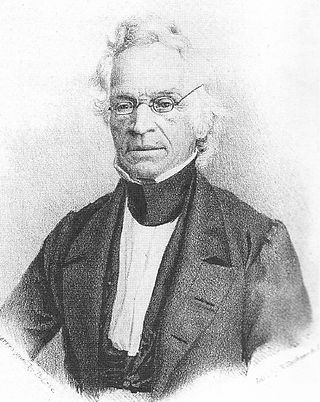
George Brown was an Irish-American investment banker and railroad entrepreneur.

The Randolph family of Virginia is a prominent political family, whose members contributed to the politics of Colonial Virginia and Virginia after statehood. They are descended from the Randolphs of Morton Morrell, Warwickshire, England. The first Randolph in America was Edward Fitz Randolph, who settled in Massachusetts in 1630. His nephew, William Randolph, later came to Virginia as an orphan in 1669. He made his home at Turkey Island along the James River. Because of their numerous progeny, William Randolph and his wife, Mary Isham Randolph, have been referred to as "the Adam and Eve of Virginia". The Randolph family was the wealthiest and most powerful family in 18th-century Virginia.

Philip Evan Thomas was the first president of the Baltimore and Ohio Railroad (B&O) from 1827 to 1836. He has been referred to as "The Father of American Railways". The Thomas Viaduct bridge in Relay, Maryland, was named after him.
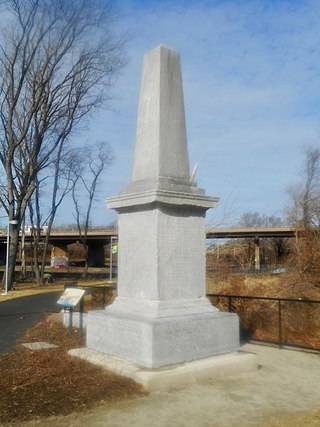
The Newkirk Viaduct Monument is a 15-foot white marble obelisk in the West Philadelphia neighborhood of Philadelphia, Pennsylvania. Installed in 1839, it is inscribed with the names of 51 railroad builders and executives, among other information.
Lewis Brantz was a trader in Baltimore, Maryland; a ship captain; and the first president of the Baltimore and Port Deposit Railroad, part of the first rail link between Philadelphia and points south.
Jacob I. Cohen Jr. was an American banker, railroad executive, and civic leader in Baltimore who helped win the right for Jews to hold public office in Maryland.
Roswell Lyman Colt (1779-1856) was an American businessman who made a fortune in the shipping industry, served for decades as governor of the Society for Establishing Useful Manufactures, and was an early railroad executive.
Edward Tatnall (1782–1856) was an American miller and railroad executive based in Wilmington, Delaware.

Charles Frederick Mayer (1795-1864) was an American lawyer, Maryland state senator, and railroad director.
James P. Stabler (1796–1840) was a chief engineer for two of the earliest railroads in the United States.

William Patterson (1752–1835) was a businessman, a gun-runner during the American Revolution, and a founder of the Baltimore and Ohio Railroad. His many business dealings included shipping, banking, and the Baltimore Water Company.

John Hazlehurst Boneval Latrobe was an American lawyer and inventor. He invented the Latrobe Stove, also known as the "Baltimore Heater", a coal fired parlor heater made of cast iron and that fit into fireplaces as an insert. He patented his design in 1846. The squat stoves were very popular by the 1870s and were much smaller than Benjamin Franklin's Franklin stove.
Henry R. Hazlehurst (1815-1900) was an American civil engineer. Long employed by the Baltimore and Ohio Railroad, he also helped build the first rail link between Philadelphia, Pennsylvania, and points south.